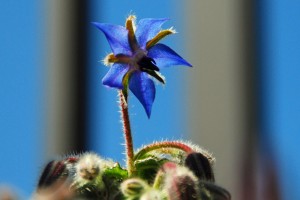Borage
Botanical Name: Borago Officinalis
In the late Middle Ages, Physicians recommended Borage; they believed it supplied courage, confidence, cheerfulness and restoring life. Today, we know that it stimulates the production of adrenaline, which prepares the body to handle stress (the medieval beliefs were well founded). Other names for Borage: “good cheer”, “dear friend” and “sparkling eyes”. This reflects borage’s ability to brighten the mood. Rich in a polyunsaturated fatty acid, Borage seed oil is used to address metabolic problems from obesity to premenstrual complaints. It also promotes lactation, helps break a fever by inducing a sweat and breaks up phlegm while easing sore throats and coughs.
Help for viral infections:
- A Borage and Echinacea tea have a calming effect.
- Reduces fever and induces sweating.
- Helps combat measles, mumps, chicken pox, colds and flus.
- Mix equal amounts of fresh borage leaves and powdered Echinacea root. Brew in hot water, steep for 10 min. and sweeten with honey. Drink 1 cup 3 times per day.
Therapeutic Effect:
- Borage leaves are diuretic, it increase sweat and urine.
- It acts as an adrenal stimulant, useful for countering stress and lingering effects of steroid therapy.
- Tea made from Borage soothes sore throats and irritated coughs.
Components:
- The seed oil contains gamma linoleic acid. Found primarily in vegetable oils and used as a dietary supplement for treating problems with inflammation and auto-immune diseases.
- The acid is used to to treat metabolic disturbances, including obesity, premenstrual syndrome, eczema, high blood pressure and alcoholism.
- Recent evidence suggests Borage may be useful for treating heart disease and cancer.
- The leaves are a good source of vitamin C, organic calcium and potassium, essential oils, tannins and mucilages. It’s also has saponins that strengthen resistance and flavonoids that prevent infection.
- The silicic acid in Borage stimulates hormone production and balances mood swings.
For lactation:
- A Borage tea will help promote healthy milk flow while you’re nursing.
- Add a generous handful of fresh Borage leaves to ½ gal. of lemonade, or to the same amount of a mild hot tea, which ever flavor you enjoy – chamomile, fennel, nettle and violet blossoms are Excellent choices.
- Let steep for at least 20 minutes, then strain through a paper filter. Drink a cup 3-4 times a day for best results.
From your garden
- Borage is hard to find commercially. If you plan to make it a regular part of your diet, plant it in your garden. It attracts honeybees, ensuring pollination of other plants.
- Plant the herb in sandy soil in which water drains rapidly. Sow in mid-or late spring, in full sun or partial shade, and again in early and midsummer.
- Borage is an annual, it will die at the end of the season, but self sown seedlings germinate for replacement plants.
- For medicinal use, the leaves are best gathered before the flower buds appear. The plant is easily bruised, so handle gently and use right away. The young leaves have a prickly texture that are edible.
Kitchen Hints
- Preserve Borage in vinegar or in an alcohol tincture. It does not dry or freeze well.
- Capture the flavor of Borage over the long term by making a blue vinegar from the blossoms or an emerald green vinegar from the leaves. These vinegars make wonderful gifts in decorative bottles.
- “Cucumber herb” is another name for borage, and complement plain and pickled cucumbers. It adds flavor to salads, soups and summer stews. Try with eggs and fish.
- The pretty blue blossoms are also edible. Remove the green sepals on the undersides before using, then sprinkle the flowers over soups and salads.
- Freeze the flowers in ice for a garnish for punches and other summer drinks.
- For cooking, use young leaves that are no larger than a half dollar. For teas, the bigger leaves are fine.
- Borage is an essential ingredient to many Italian dishes. Borage risotto is very popular, as is ravioli stuffed with borage.
- To enhance the flavor of dishes, sprinkle Borage leaves or stir them in before serving. It loses much of it’s flavor and aroma, once cooked.
Tip: Cut borage leaves into thin strips and mix into strawberry punch. Strain the punch through a paper filter before serving.
References:
- The Complete Guide to Natural Healing
- Note: Consult with a Physician or certified herbologist if you are seeking medical remedies. The information is not intended as medical advice. PagansWorld.org is not liable for the misuse of the herb listed above.
Thanks for stopping by! Well wishes to you all, have a great day!





